
Guidance for Digital Experiential in Briefing Programs
Today, B2B enterprise selling is about teaching, learning and collaborative problem solving. It’s highly personalized, engages teams of buyers and influencers rather than individuals and puts the focus on sustained relationships and value creation, as opposed to just the transaction.
All of this is happening at a time when sellers are less involved in the buying process than they were in the past: research shows that B2B customers are, on average, 37% of the way through a purchase process by the time they reach the solution-definition stage, and 57% of the way through the process before they engage with supplier sales reps (source: HBR, “Making the Consensus Sale”).
How did we get here? Starting in the early 2000s, increased information availability transferred power from seller to buyer. With content everywhere, the traditional knowledge advantage favoring sellers ended. And with less face time than ever, sellers began to focus even more on enhancing the time they do have with buyers.
This brings us to where we are now: these trends have thrust live brand experiences such as trade shows, conferences and briefing programs into the corporate spotlight. We’re seeing huge investments in these areas to maximize live interactions, but especially in two strategic areas: (1) linking creative, immersive digital experiential across live mediums to provide a consistent customer experience and (2) capturing the right data with an analytics engine to help make better decisions and drive better outcomes.
”With these trends in mind, at Helios, our belief is that digital experiential is a core capability and tool set that every organization has to master to sell effectively today.”
Immersive Digital Experiences Build Buyer Trust
Specifically in the corporate briefing center, we’re talking about immersive digital experiential techniques like multi-touch surfaces, gesture/reactive surfaces and environments, augmented reality, virtual reality, transparent LCDs, voice recognition and similar engagements. These are the front-end tools that help bring the brand and product story to life in a highly personalized, custom manner while facilitating seller-led solution building and conversation.
These can be highly portable and modular so they can be moved around the space, taken on customer/VIP visits and travel to events…or become part of the very fabric of the briefing center. Regardless, the fundamental aim should be to tell the story immersively, allow guests to configure the content to their own objectives and deepen the conversation in measurable ways.
We think the next big opportunity is to shift thinking towards an “outside-in” approach where the creative and operational plan for digital experiential takes the broader customer journey into account – for briefing program managers to collaborate with sales, event leads and product teams so that creatively and operationally these experience are consistent everywhere buyers are engaged.
The practical impact of this approach is that the brand experience is the same when a buyer visits a trade show booth, attends a conference and/or visits the briefing center. It cascades to high-level sales meetings and other VIP experiences that make up today’s sales process. By making sure that interactive creative (concept, UX, UI, form factor etc.) is consistent across all these touch points, sellers reinforce the idea that they have a complete solution that’s seemingly bespoke to the buyer’s wants and needs.
”The briefing program team is in a position to raise the call and lead the charge here.”
In an era where the buying team might encounter the seller physically only a few times across these different mediums, the briefing program team is in a position to raise the call and lead the charge here.
Good Information Accelerates Sales
Pivoting away from the customer-facing digital experiential, briefing program managers must also look at the back-end operation for data capture and analytics.
The capability that needs to be developed is to capture and share data from customer interactions so that other marketing teams and sales leads can act more intelligently and as quickly as possible.
Paying attention to and refining the data layer can have a big impact, and in many cases requires only tweaks to existing tactics existing systems. For example: asking better questions at point of guest registration, requiring a salesperson to input better data during scheduling, mining reports from the briefing center’s CMS about what kinds of content visitors/conference spend time on…these are all inputs that should flow across the organization.
In a world when time with customers is at premium, we think digital experiential embodies the next generation of B2B best practice – a better storytelling and deal-building approach for today’s consensus buyers with whom we spend less face time than ever.
”We think digital experiential embodies the next generation of B2B best practice.”
Consistency of digital experience and great insights from their interactions with these tools will help sellers outperform competitors. And briefing program managers are better positioned to call attention to these strategies than anyone else.
